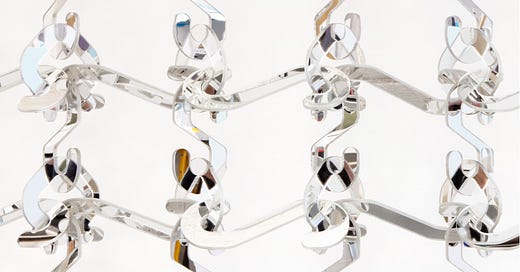Ghost Pearls, mirror acrylic sheet, 96 x 108 x 4 inches, 2022
Today I have a new solo exhibition opening at Granary Arts, a non-profit art space in Ephraim, Utah. For the past year and a bit, I’ve been a Granary Arts Fellow, making trips to the local environs to research the scene and snoop around libraries.
My work for the show is a sculpture, eight feet high and nine feet wide, suspended from a wooden beam in the center of the gallery. The sculpture is a kind of lace, except that it’s woven from mirror—1,005 individually-cut pieces of acrylic mirror interlock to form an open, permeable, floor-to-beam fabric—reflecting back the architecture, itself, and you.
Titled Ghost Pearls, the piece was inspired by a brew of conversations with local and regional lace-makers; historical links between lace, value and time; early digital artworks like A. Michael Noll’s Ninety Parallel Sinusoids with Linearly Increasing Period; phenomenological sculpture from the Light and Space movement; and a whole bunch more.
Lace is an open, web-like pattern. It came into prominence and fashion in the sixteenth century as a kind of proof-of-work, Veblen good, valuable in part because it required such extraordinary attention and labor to produce. The word derives from the Old French las, meaning noose, akin to the Latin lacere, meaning to entice or ensnare. Lace has this capacity, to ensnare our gaze in its web. When I look at images of their gossamer dresses, bibs, and collars, I can’t help but wonder if the women of the sixteenth century onward were weaving a pre-internet of silken connectivity, hinting in their work at the hyperlinked structures to come.
On a visit to Ephraim this July, word got around town that I was into lace, and a local artist named Julie Johnson invited me to lunch at her home. She taught me the basics of tatting, a type of lace-making, and showed me a crystalline piece she’s been working on for the past seven years. Larger than a kitchen table, it dangled from her outstretched arms with the atmospherics of summer clouds. In the days before and after, I perused the lace collection at the nearby Fairview Museum. By chance, on the last day of my trip, the museum convened an informal meeting of six lace-makers from across the state; in a circle of chairs across from a colossal mammoth skeleton they each demonstrated a different form of bobbin lace-making. Every conversation about lace circled back to time, particularly the in-between time of women’s work mingling with family life. It’s fascinating to me that lace has occupied a unique, dual territory in history as both a humble, domestic activity and high-status good.
I was always hungry for phenomenology. In the evenings I hunted sunsets, looping out of town down one-lane country roads, or walking circuits around the Pioneer Cemetery, where graves are marked by local oolite limestone, sanded by the years to rounded stumps with grainy edges. I was there with the ghostly pioneers I’d read about hours before, and also here on the www, dinged by Slack, checking flickering screens, and all of these waves mingled. Every ten hour drive to and fro Utah was a meditation—slipping by acres of mirror solar arrays in the Nevada desert, trailing cloud lightning over lilac mountain ranges, weaving through night canyons—catching quiet dramas in a play of light. Loosened by that spaciousness, secret thoughts and threads unfurl. It’s easy to note the hours of fabrication that go into making a sculpture, but much harder to place the subtle stitches that gave it life.
Ghost Pearls is a virtual weaving. As you approach, it poses questions like, where are you, and what will you focus on? Because it’s a mirror matrix where parts join at angles, the sculpture reflects back its surroundings at unusual angles—strips of the ceiling hover down at low levels, the floor is reflected high. As you stroll, multiple versions of you quaver in and out of view like apparitions. You can fall into the wobbly depths of its reflections, or focus on the fabric pattern itself, which oscillates in a wave form. It’s both quiet and destabilizing as you move around, proffering shape-shifting views, superimposing what’s behind you with what’s in front. We use mirrors every day in our homes for self-reflection, in our cars for navigation, and throughout city cores as cladding for skyscrapers. Here mirror becomes a woven, rippling wave, and an invitation to surf.





Super inspired by lace as feminine hyperlinks hundreds of years ago ❤ Looking forward to videos of this beautiful mirror lace!